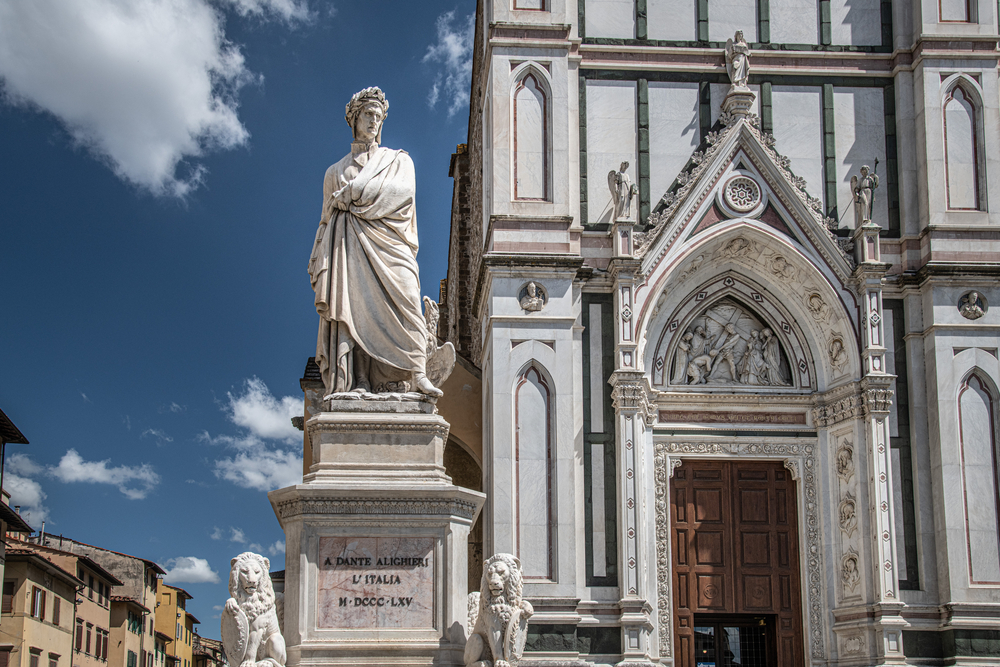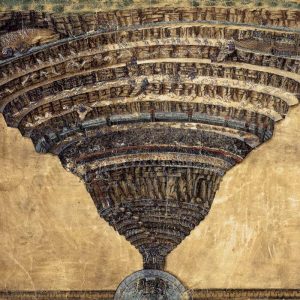Dante Alighieri, born sometime between 21 May and 20 June 1265 in Florence, was not only a master poet of the Middle Ages but also a visionary who redefined literature, theology, and the Italian language. Widely regarded as the “Father of the Italian Language,” his work forms the cornerstone of Italy’s literary canon.
Most famously, Dante Alighieri authored The Divine Comedy, a monumental epic that charted the spiritual journey of the human soul. Yet Dante was far more than a poet. He was a philosopher, political theorist, and fierce moral critic.
A life shaped by exile and longing

Dante’s birth came at a time when Florence was a city of wealth, creativity, and political chaos. He was born into a family of moderate standing, not aristocratic but well connected. His education was classical and scholastic: he studied Latin, theology, philosophy, and the poetry of the troubadours. Among his early influences were the Roman poet Virgil, the Christian theologian Thomas Aquinas, and the Provençal poets of courtly love.
His life took a definitive turn in 1302, when he was exiled from Florence during the intense factional struggles between the Guelphs and Ghibellines. Accused of corruption and financial wrongdoing, charges widely seen as politically motivated, he was sentenced to death if he ever returned. He never did.
This exile haunted Dante for the rest of his life. Cut off from his city, his family, and political ambition, he turned inward; and upward. The pain of separation transformed into a poetic journey toward spiritual redemption and divine truth.
Beatrice – his muse and the mystery
Central to Dante’s poetry is the figure of Beatrice, whom he first encountered when they were both around nine years old. Although they may have met only briefly in life and Beatrice married another man, she became the guiding star of his poetic imagination.
In La Vita Nuova (The New Life), written around 1294, Dante recounts his love for Beatrice in a series of sonnets and prose passages that merge real-life experience with spiritual symbolism. The work captures the purity of idealised love while hinting at a broader metaphysical dimension. Beatrice, in this context, is not only a woman but an allegory of divine grace and wisdom.
It is in The Divine Comedy, however, that Beatrice takes on her fullest form. She is both the endpoint and the guide of Dante’s journey through the afterlife, representing theology and divine revelation. When Virgil, the embodiment of reason, can go no further, it is Beatrice who leads Dante into Paradise.
The Divine Comedy

The Divine Comedy is Dante’s magnum opus and one of the greatest works of world literature. Composed between 1308 and Dante’s death in 1321, the poem is divided into three cantiche: Inferno (Hell), Purgatorio (Purgatory), and Paradiso (Paradise). Each consists of 33 cantos, with an introductory canto making the total 100.
The work is written in terza rima, a rhyme scheme of interlocking tercets (aba, bcb, cdc…), which Dante invented. It is composed in the Tuscan dialect, a choice that would have profound implications for the future of the Italian language.
In Inferno, Dante explores the depths of sin. Guided by Virgil, he descends through nine concentric circles of Hell, each one punishing a different type of sinner—from the lustful to the treacherous. The punishments are symbolic, revealing a deep moral logic: flatterers are drowned in excrement, the wrathful tear each other apart, and traitors are frozen in ice.
Purgatorio depicts a more hopeful realm, where souls cleanse themselves of sin. Here, Dante presents a model of spiritual development, guided by repentance, effort, and divine grace. The tone is more lyrical and contemplative than that of Inferno.
In Paradiso, Dante’s journey reaches its climax. Beatrice leads him through the celestial spheres, where he encounters saints, theologians, and ultimately God. The language becomes increasingly abstract, attempting to describe realities beyond human comprehension. The final vision, which is of the beatific presence of God as a blinding point of light within which Dante perceives the mystery of the Trinity, is one of the most audacious theological statements in all of literature.
Also read: Dante and the Divine Comedy
Father of modern Italian
Dante made the radical decision to write The Divine Comedy not in Latin, the language of scholarship, but in the vernacular Tuscan dialect. This choice helped establish the foundations of modern Italian. His syntactic elegance, expressive power, and philosophical depth set a new standard. Later writers like Petrarch and Boccaccio, who admired and built upon his style, completed the so-called “Three Crowns” of Italian literature.
More than a linguistic innovator, Dante Alighieri was a moral philosopher. His poetry is filled with commentary on ethics, politics, love, and justice. His judgments were fearless. He placed popes in Hell, kings in Purgatory, and obscure Florentine citizens in Paradise. He used poetry not only to reflect his times but to critique them and offer an alternative vision rooted in divine order.
Political thought and other works
Dante’s intellectual reach extended beyond poetry. In De Monarchia, he argued for the separation of Church and State and for a universal monarchy that would bring peace and justice. Written in Latin, it reveals his deep engagement with Aristotelian and Thomistic thought.
He also wrote Convivio (The Banquet), a kind of encyclopaedia in the vernacular, intended to educate the lay reader in philosophy, ethics, and the sciences. De Vulgari Eloquentia, another Latin treatise, examines the potential of vernacular languages to express complex ideas, laying the groundwork for the legitimacy of Italian as a literary language.
Death and immortality
Dante Alighieri died in Ravenna in 1321, likely of malaria, shortly after completing Paradiso. He was buried there, and Florence, his beloved city, has for centuries sought to repatriate his remains. In 1829, a cenotaph was built in Florence’s Santa Croce, still empty, bearing the inscription: “Honour the supreme poet.”
But Dante’s true monument is not of stone. It is his poetry, which continues to influence writers, artists, and thinkers from T.S. Eliot to Primo Levi, from Botticelli to Salvador Dalí. His journey through Hell, Purgatory, and Paradise is more than a medieval Christian allegory; it is a profound exploration of the human condition, the search for meaning, and the longing for transcendence.





